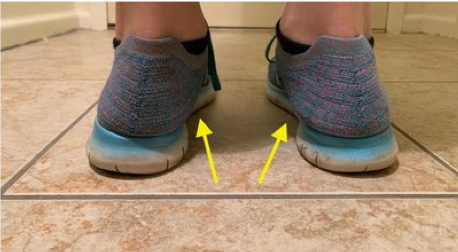The human foot has 33 joints that hold together 26 different bones and over 100 muscles, tendons, and ligaments. The arches of the feet provide the spring to your step and help to distribute body weight and all its compressive forces across your feet and legs. The structure of the foot arch determines how a person walks and needs to be both sturdy and flexible.
What are flat feet?
Flat feet, also known as pes planus or fallen arches, is a postural deformity that occurs when the arch of the foot collapses and comes into complete or near-complete contact with the ground. This condition may occur at the time of birth or develop over time as a result of aging or injury. Flat feet can usually be self-diagnosed, either by the “wet footprint test” or the “shoe inspection test.” Simply wet your feet and look at the wet imprint of your foot. The thicker the imprint between the heel and ball of the foot, the flatter the foot. By contrast, a high arch foot will only show your heel and the top part of your foot near your toes.

Similarly, if you inspect your shoes and see more wear on the inside of the soles, that would be evidence of flat feet. The shoe’s upper will also tend to lean inward over the sole as a result of the faulty foot mechanics. Flat feet are typically associated with excessive pronation of the foot. Overpronation occurs when the arch of the foot descends downward and inward as the foot strikes the ground. This overpronation causes the foot to be less able to absorb shock, placing greater stress on the feet, ankles, and knees.
Flat feet symptoms
If you are having problems with shin splints, back pain, your knees, or hips, you may want to consider looking at your feet as the cause. When you walk, you put as much as five times your body weight in force on each foot. If your foot doesn’t absorb that shock properly, it can cause other problems, and is why people with flat feet typically experience pain in the midfoot region.
If you have flat feet, your foot will tend to roll inward as you walk. That extra motion can create other stresses further up your legs. This pain tends to increase with activity and may also present swelling along the inner ankle and arch, as well as hip, knee, and lower back pain. Flat feet can also lead to tendinitis in your Achilles tendon because that tendon must over-compensate when you push off with your feet.
Overpronation can put unnecessary stress on your knees. When your foot over-pronates, your leg rotates inward causing the knee to flex and extend while pointing inward. This is not the normal direction for the knee and puts additional stress on the joint. Overpronation can also affect the hip joints. When the foot pronates, the leg rotates inward and the hip joints can become misaligned. This condition puts additional stress on the hip and on the entire leg muscles.
Treatments for flat feet
The treatment for flat feet, and joint pain associated with having flat feet, can vary. Physicians typically recommend a conservative approach, with surgery reserved for only the most server cases.
PROPER FOOTWEAR
Healthy footwear can play a significant role in reducing knee and hip pain associated with flat feet. High heels increase the risk of knee joint degeneration so try to always wear low-heeled shoes. However, flat shoes also need to be carefully considered as many do not provide adequate arch support and that can lead to knee, hip, and back pain.
When shopping for footwear, take the time to find a proper-fitting shoe as tight shoes can create foot pain and oversized shoes can affect your gait. Stability sneakers provide cushioning and help control over pronation. If knee and hip pain are due to poor foot mechanics, then proper footwear along with orthotic insoles can be a very effective way to relieve joint pain.
ORTHOTIC INSOLES
People with persistent or severe joint pain symptoms caused by flat feet may benefit from orthotic arch supports. Orthotic supports are used to modify the structure of your foot. While there are companies that manufacture custom corrective shoes, these are usually quite expensive. Similarly, custom orthotics prescribed by a podiatrist can also be costly and many people find them to be very rigid and uncomfortable.
If your condition is not too severe, you may get relief from the many different cushioning insoles sold at your local pharmacy. Just remember to replace them once their supporting cushioning becomes worn down as they will no longer be helpful. If your condition is a bit more severe or you are looking for a durable product that will not degrade quickly like foam or gel inserts, you may want to try a hybrid insole, like SelectFlex. SelectFlex gives you all the benefits of expensive custom orthotics at a fraction of the cost, and the adjustability feature of SelectFlex allows you to customize the level of arch support that your unique condition requires.
FOOT STRETCHES
There are many stretching exercises you can do to increase arch flexibility and strength and can be very helpful for people suffering from the side effects of flat feet. You can strengthen the intrinsic muscles in the foot by picking up marbles with your toes, stacking items with your toes, and writing numbers in the sand with your big toe. To stretch the plantar fascia ligament thereby improving arch flexibility and alleviating aches and pains, roll a golf ball forward and back under the arch of the foot, while seated. A runner’s stretch is also great to lengthen the calf muscle and Achilles tendon, both of which can cause pronation when tight.
OTHER TREATMENTS
Other exercises and therapeutic massage may also help with arch flexibility and pain relief. The downward dog yoga pose is great for lengthening and strengthening calf muscles and Achilles tendons. Heel cord stretching is a great exercise to stretch the Achilles tendon and posterior calf muscles, as a tight Achilles tendon will encourage the foot to roll inward.
Doctors may advise some people to rest until their symptoms improve and to avoid activities that could aggravate their condition. When obesity is the cause of flat feet, losing weight may improve the symptoms.
SEEKING TREATMENT FOR FLAT FEET
Know when to seek help from a medical professional. When pain is severe and interferes with your daily activities, it’s time to see the doctor for a thorough examination and treatment. If needed, flat foot surgery can provide permanent relief and may even create an arch where none existed. The surgical solution will ultimately be based upon your age, your exact symptoms, and the nature of your structural deformity.














